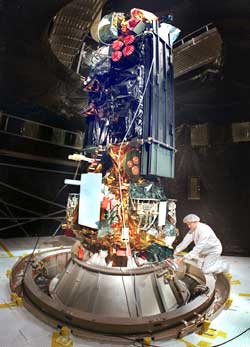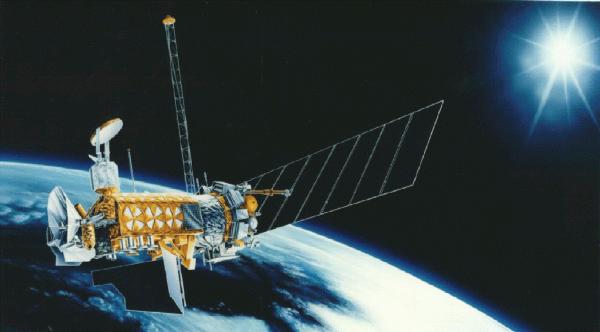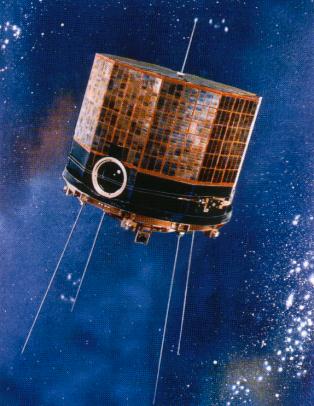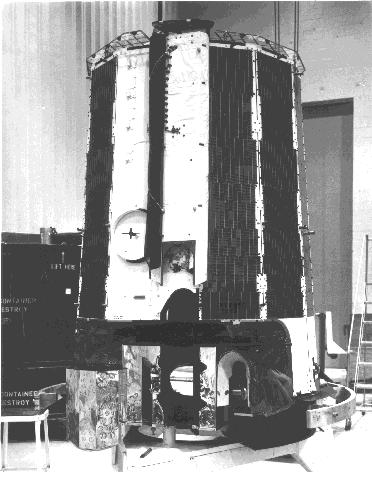General Electric WS-1 DMSP Block 5D-2/3
The designation WS-1A refers to the Block 5D-2 series of the Defense Meteorological Satellite Programme (DMSP) which were based on the earlier Block 5D-1 series of meteorological satellite. The Block 5D-2 satellites, which had a mass on 770 kg, were built by General Electric.
 |
| Image: Lockheed Martin |
| WS-1A |
The instrumentation on board of the satellites varies from satellite to satellite and consisted of the following instruments:
- an Operational Line Scan (OLS) system which provides images with a resolution of up to 3 km in the visible and infra-red bands;
- an infra-red temperature and moisture sounder (SSH/2);
- a scanning X-ray spectrometer (SSB/A);
- a precipitating electron/ion spectrometer (SSJ/4);
- an ionospheric plasma monitor (SSI/E);
- a microwave temperature sounder (SSM/T);
- a microwave imager (SSM/I);
- an ionospheric plasma scintillator monitor (SSI/ES);
- a magnetometer (SSM);
- a space radiation dosimeter (SSJ);
- an advanced X-ray detector (SSB/X); and
- an X-ray detector (SSB/S).
| DMSP F-6 | OLS, SSJ/4, SSB/A, SSI/E | ||
| DMSP F-7 | OLS, SSJ/4, SSM/T, SSM, SSI/E, SSJ, SSB/S | ||
| DMSP F-8 | OLS, SSJ/4, SSI/ES, SSB/X. SSM/T | ||
| DMSP F-9 | OLS, SSJ/4, SSM/I, SSI/ES, SSB/X, SSM/T, SSM(?), SSH/2(?) | ||
| DMSP F-10 | OLS, SSJ/4, SSM/I, SSI/ES, SSB/X, SSM/T | ||
| DMSP F-11 | OLS, SSJ/4, SSM/I, SSI/ES, SSB/X, SSM/T, SSM(?) | ||
| DMSP F-12 | OLS, SSJ/4, SSM/I, SSI/ES, SSB/X, SSM/T, SSM(?) | ||
| DMSP F-13 | OLS, SSJ/4, SSM/I, SSI/ES, SSB/X, SSM/T, SSM(?) | ||
| DMSP F-14 | OLS, SSJ/4, SSM/I, SSI/ES, SSB/X, SSM/T, SSM(?) | ||
| Instruments for each individual DMSP F satellite | |||
Like the earlier DMSP satellites, they were placed in pairs in sun-synchronous orbits in such a manner that one satellite crossed the equator at 6.30 local time followed by the other satellite at noon.
 |
| Photo: Author's collection |
| WS-1B DMSP F-15 (1999-067A) |
Commencing with DMSP F-15 the satellites were fitted with larger sensors payloads and were also known as the Block 5D-3 series which carried the designation WS-1B. The instruments carried were:
- the Operational Linescan System (OLS) weather imager
- the SSMIS (microwave imager and sounder)
- the SSULI ultraviolet limb imager
- the SSUSI ultraviolet spectrographic imager and nadir airglow photometer
- the SSI/ES-3 thermal plasma instrument
- the SSJ/5 precipitating particle spectrometer
- the SSF laser threat warning sensor
Four satellites remain in storage for future launch.
 |
| Image: USAF |
| WS-1B |
| Name | Intl. Designation | Launch | Re-entry | Notes |
|---|---|---|---|---|
| DMSP 5D-2 F-6 | 1982-118A | 21-Dec-1982 | Also known as Ops-9845 | |
| DMSP 5D-2 F-7 | 1983-113A | 18-Nov-1983 | Also known as Ops-1294 | |
| DMSP 5D-2 F-8 | 1987-053A | 20-Jun-1987 | Also known as USA-26 | |
| DMSP 5D-2 F-9 | 1988-006A | 3-Feb-1988 | Also known as USA-29 | |
| DMSP 5D-2 F-10 | 1990-105A | 1-Dec-1990 | Also known as USA-68 | |
| DMSP 5D-2 F-11 | 1991-082A | 28-Nov-1991 | Also known as USA-73 | |
| DMSP 5D-2 F-12 | 1994-057A | 29-Aug-1994 | Also known as USA-106 | |
| DMSP 5D-2 F-13 | 1995-015A | 24-Mar-1995 | Also known as USA-109 | |
| DMSP 5D-2 F-14 | 1997-012A | 4-Apr-1997 | Also known as USA-131 | |
| DMSP 5D-3 F-15 | 1999-067A | 12-Dec-1999 | Also known as USA-147 | |
| DMSP 5D-3 F-16 | 2003-048A | 18-Oct-2003 | Also known as USA-172 | |
| DMSP 5D-3 F-17 | 2006-050A | 4-Nov-2006 | Also known as USA-191 | |
| DMSP 5D-3 F-18 | 2009-057A | 18-Oct-2009 | Also known as USA-210 | |
| DMSP 5D-3 F-19 | 2014-015A | 03-Apr-2014 | Also known as USA-249 |
Launch dates of the Block 5D-2/3 series
Background history
The first steps towards developing a series of meteorological satellites under the designation of Defense Meteorological Satellite Program (DMSP) where taken in 1962 when the RCA Corporation developed a number of satellites identified in the P35 series which were grouped in generations known as 'Blocks'. Of these Blocks 1 and 2 must be considered as experimental satellites. Over the time period during which the satellites were launched the instrumentation on board of the satellites was progressively improved. Whereas early satellites, such as those in the Block 4A series, were equipped with two vidicon cameras, later satellites utilised line scan cameras operating in the visual and infra-red bands of the spectrum. Other instruments that were carried included temperature sounders and data collection and transmission systems. All the successful satellites in the P35 series were placed in a sun-synchronous orbit.
Block 1
The Block 1 military meteorological satellites were developed by RCA. The mass was 91 kg. The satellites were fitted with a single camera system. The entire programme was known as Program II, Program 694BH and Program 417.
 |
| Image: Author's collection |
| DMSP Block 1 P35-2 (1962 αο1) |
| Name | Intl. Designation | Launch | Re-entry | Notes |
|---|---|---|---|---|
| P35-1 | --- | 23-May-1962 | --- | Also known as Ops-1201 and FTV-3501; failed to orbit |
| P35-2 | 1962 αο1 | 23-Aug-1962 | Also known as Ops-3502 and FTV-3502 | |
| P35-3 | 1963-005A | 19-Feb-1963 | 26-Dec-1979 | Also known as Ops-0240 |
| P35-4 | --- | 26-Apr-1963 | --- | Also known as Ops-1298; failed to orbit |
| P35-5 | --- | 27-Sep-1963 | --- | Also known as Ops-1610; failed to orbit |
Launch dates of the Block 1 series
Block 2
The RCA Block 2 military meteorological satellites were a development of the Block 1 series. The series was also known as AFP-43 and the satellites had a mass of 130 kg. They were fitted with two camera systems.
| Name | Intl. Designation | Launch | Re-entry | Notes |
|---|---|---|---|---|
| P35-6 | 1964-002B | 19-Jan-1964 | Also known as Ops-3367 | |
| P35-7 | 1964-002C | 19-Jan-1964 | ||
| P35-8 | 1964-031A | 18-Jun-1964 | Also known as Ops-4467 | |
| P35-9 | 1964-031B | 18-Jun-1964 |
Launch dates of the Block 2 series
Block 3
The RCA Block 3 series was based on the RCA Block 2 series. The satellites had a mass of 150 kg.
| Name | Intl. Designation | Launch | Re-entry | Notes |
|---|---|---|---|---|
| P35-10 | 1965-003A | 19-Jan-1965 | 13-Jul-1979 | Also known as Ops-7040 |
| P35-11 | 1965-021A | 18-Mar-1965 | 31-Dec-1989 | Also known as Ops-7353 |
| P35-12 | 1965-038A | 20-May-1965 | Also known as Ops-8386 | |
| P35-13 | 1965-072A | 9-Sep-1965 | Also known as Ops-8068 | |
| P35-14 | --- | 6-Jan-1966 | --- | Also known as Ops-2394; failed to orbit |
| P35-15 | 1966-026A | 31-Mar-1966 | Also known as Ops-0340 |
Launch dates of the Block 3 series
Block 4A
The RCA Block 4A satellites had a mass of 125 kg. The satellites were equipped with two vidicon cameras.
| Name | Intl. Designation | Launch | Re-entry | Notes |
|---|---|---|---|---|
| P35-16 | 1966-082A | 16-Sep-1966 | Also known as Ops-6026 | |
| P35-17 | 1967-010A | 8-Feb-1967 | Also known as Ops-6073 | |
| P35-18 | 1967-080A | 23-Aug-1967 | Also known as Ops-7202 | |
| P35-19 | 1967-096A | 11-Oct-1967 | Also known as Ops-1264 |
Launch dates of the Block 4A series
Block 4B
The RCA Block 4B satellites had a mass of 195 kg.
| Name | Intl. Designation | Launch | Re-entry | Notes |
|---|---|---|---|---|
| P35-20 | 1968-042A | 23-May-1968 | Also known as Ops-7869 | |
| P35-21 | 1968-092A | 23-Oct-1968 | Also known as Ops-4078 | |
| P35-22 | 1969-062A | 22-Jul-1969 | Also known as Ops-1127 |
Launch dates of the Block 4B series
Block 5A
The Block 5A satellites had a mass of 195 kg.
| Name | Intl. Designation | Launch | Re-entry | Notes |
|---|---|---|---|---|
| P35-23 | 1970-012A | 11-Feb-1970 | Also known as Ops-0054 and DAPP 1524 | |
| P35-24 | 1970-070A | 3-Sep-1970 | Also known as Ops-0203 and DAPP 2525 | |
| P35-25 | 1971-012A | 17-Feb-1971 | Also known as Ops-5268 and DAPP 3526 |
Launch dates of the Block 5A series
Block 5B/C
The Block 5B series satellites had a mass of 195 kg. The Block 5C satellites commenced with DMSP-3.
 |
| Photo: Author's collection |
| DMSP Block 5C DMSP-3 (1972-089A) |
| Name | Intl. Designation | Launch | Re-entry | Notes |
|---|---|---|---|---|
| DMSP-1 | 1971-087A | 14-Oct-1971 | Also known as Ops-4311 and P35-26 | |
| DMSP-2 | 1972-018A | 24-Mar-1972 | Also known as Ops-5058 | |
| DMSP-3 | 1972-089A | 9-Nov-1972 | Also known as Ops-7323 | |
| DMSP-4 | 1973-054A | 17-Aug-1973 | Also known as Ops-8364 | |
| DMSP-5 | 1974-015A | 16-Mar-1974 | Also known as Ops-8579 | |
| DMSP-6 | 1974-063A | 9-Aug-1974 | Also known as Ops-6983 | |
| DMSP-7 | 1975-043A | 24-May-1975 | Also known as Ops-6226 | |
| DMSP-8 | 1976-016A | 19-Feb-1976 | 19-Feb-1976 | Also known as Ops-5140; failed to achieve correct orbit |
Launch dates of the Block 5B/C series
Block 5D-1
The Block 5D-1 sub-series of meteorological satellites is commonly referred to as Advanced Meteorological Satellite (AMS). The satellites, which at first had a mass of 450 kg (for AMS 1 and AMS 2) and later 513 kg (for AMS 3, AMS 4 and AMS 5), carried instrumentation which varied from satellite to satellite and included the following instruments:
- an Operational Line Scan (OLS) system which provided images with a resolution of up to 3 km in the visible and infrared bands;
- a gamma ray detector (SSB);
- an infrared temperature and moisture sounder (SSH/2); and
- a precipitating electron/ion spectrometer (SSJ/4).
The satellites were placed in pairs in sun synchronous orbits in such a manner that one satellite crossed the equator at noon local time followed by the other satellite at 6.30 pm. Real time read out from the DMSP satellites was standard, allowing the military commanders in the field to have the necessary meteorological information instantaneously.
 |
| Photo: Author's collection |
| DMSP Block 5D-1 AMS-1 (1976-091A) |
| Name | Intl. Designation | Launch | Re-entry | Notes |
|---|---|---|---|---|
| AMS-1 | 1976-091A | 11-Sep-1976 | Also known as Ops-5721 and DMSP F-1 | |
| AMS-2 | 1977-044A | 5-Jun-1977 | Also known as Ops-5644 and DMSP F-2 | |
| AMS-3 | 1978-042A | 1-May-1978 | Also known as Ops-6182 and DMSP F-3 | |
| AMS-4 | 1979-050A | 6-Jun-1979 | Also known as Ops-5390 and DMSP F-4 | |
| AMS-5 | --- | 14-Jul-1980 | --- | Failed to orbit; also known as DMSP F-5 |
Launch dates of the Block 5D-1 series
Back to Directory of U.S. Military Rockets and Missiles, Appendix 3
Last Updated: 1 February 2024